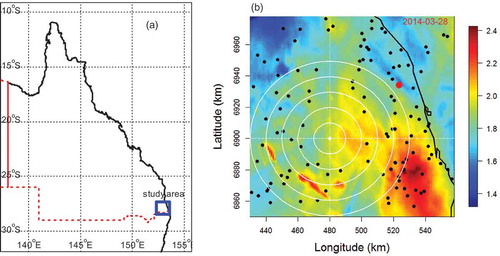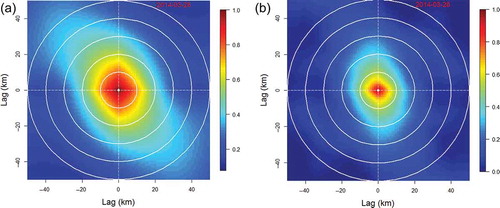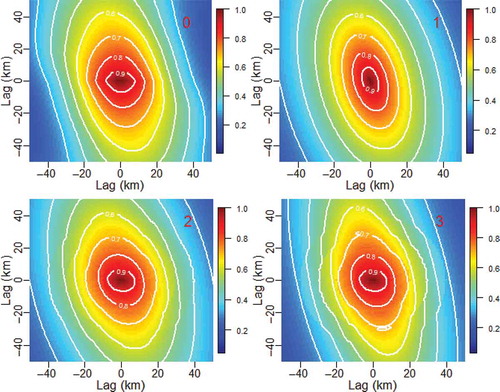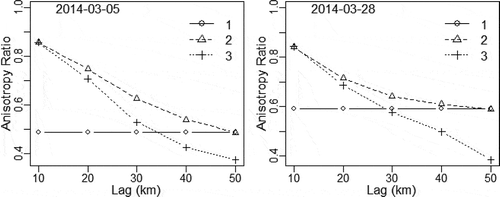Figures & data
Figure 1. Location of (a) the study area in Queensland, Australia, and (b) the 117 daily gauge stations (black dots) within the range of the Mt. Stapylton weather radar station (near Brisbane) (red dot); the radar image in log10(mm) scale is for 28-03-2014.

Table 1. Basic properties of selected wet days.
Figure 2. (a) Radar data empirical correlogram and (b) correlogram of the gauged data for 28-03-2014. Concentric circles encompass areas within {10, 20, 30, 40, 50} km radius from the correlogram map centre.

Figure 3. Correlograms generated by the regional options (0–3) parameter sets with contours superimposed; radar data of 05-03-2014.

Figure 4. Variation of the anisotropy ratio with the lag distance of the regional options parameter sets using radar data.

Table 2. Estimated correlogram parameters defined in equation (4) of the regional option 1 using gauge and radar data. Lu: major axis correlation length; η: anisotropy ratio; θ: anisotropy direction; an: correlogram sill.
Figure 5. Locally varying anisotropy (LVA) direction (θ, left panels) and the major axis correlation length (Lu in km, right panels), for radii of (a) 10 km, (b) 30 km and (c) 50 km.

Table 3. Estimated performance statistics using the different correlograms for two wet days, 10-fold case. RMSE: root mean square error; MB: mean bias; MAB: mean absolute bias; MIQR: mean inter quartile range; SD: mean standard deviation in the Gaussian domain.
Table 4. Ranked performance statistics for the correlograms, where 1 denotes best and 14 worst: 10-fold case for 24 February 2014. RMSE: root mean square error; MB: mean bias; MAB: mean absolute bias; MIQR: mean inter quartile range; SD: standard deviation in the Gaussian domain; correlogram option prefix G for gauged and R for radar.
Table 5. Ranked performance statistics for the correlograms (1 for best and 14 for worst): 10-fold case over all 12 wet days. See for abbreviations.
Figure 6. Comparison of the cross-validation median estimates (solid [blue] line) and the observed values (open circles) for correlogram option R_REG_1. The (red) dotted lines represent the 90% prediction limits. Gauge numbers are in increasing order of the median prediction for easy visualisation.
![Figure 6. Comparison of the cross-validation median estimates (solid [blue] line) and the observed values (open circles) for correlogram option R_REG_1. The (red) dotted lines represent the 90% prediction limits. Gauge numbers are in increasing order of the median prediction for easy visualisation.](/cms/asset/4ecb301f-fa0a-4a2f-83ca-537e78281328/thsj_a_1083652_f0006_oc.jpg)
Table 6. Ranked performance statistics for the correlograms (1 for best and 14 for worst): 10-fold case over all 12 wet days and by conditional simulation. See for abbreviations.

![Figure 7. Comparison of the cross-validation median estimates (solid [blue] line) and the observed values (open circles) for correlogram option R_REG_1 by conditional simulation. See Fig. 6 for explanation.](/cms/asset/99262305-eb99-4d41-af4d-7fe11bc5db51/thsj_a_1083652_f0007_oc.jpg)